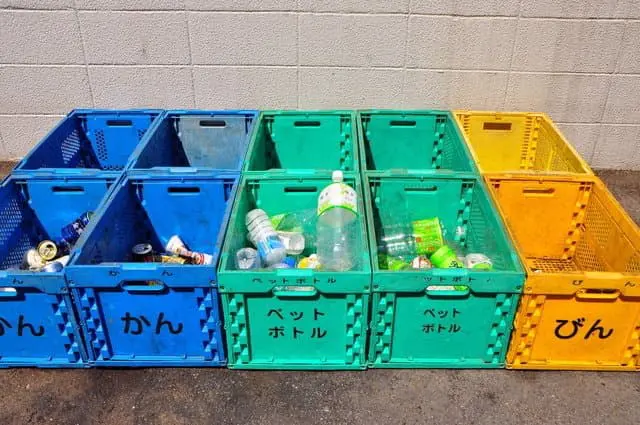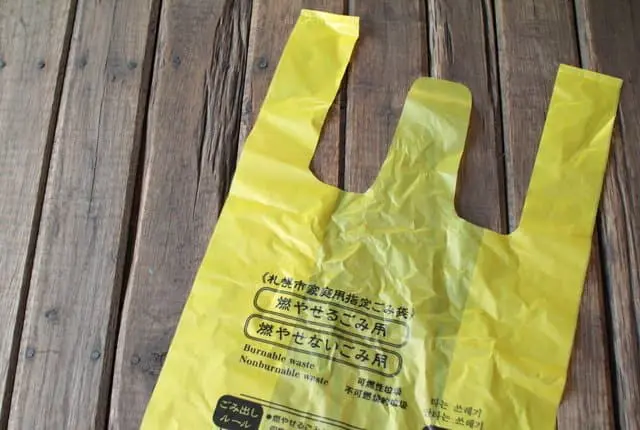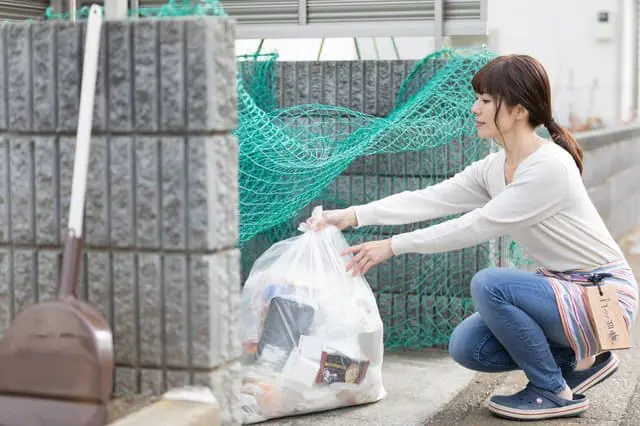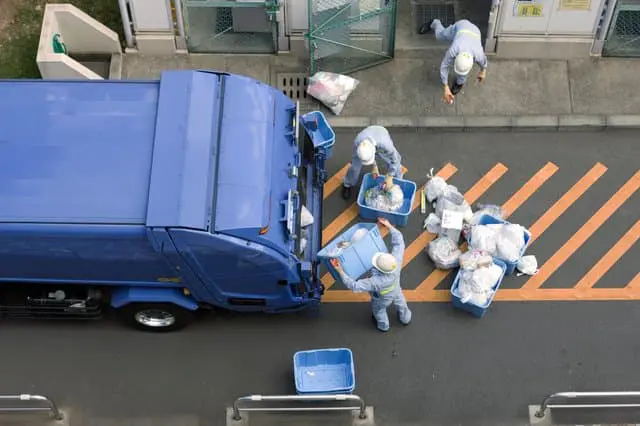How to Sort Trash in Japan: Essential Rules and Tips

Confused by Japan’s trash system? Learn how to dispose of recyclables, burnable trash, food waste, large items, and more with our article and garbage charts.
Separation and Disposal of Garbage in Japan

Upon moving to Japan, many foreign residents find the garbage disposal system confusing. In other countries, garbage is often classified into three main categories: recyclable, household, and vegetation waste.
However, most cities, towns, and villages across Japan categorize and discard waste in a very particular manner. In addition to burnable trash (i.e. paper scraps), combustibles are further separated into smaller categories, including newspapers, magazines, and plastics. Furthermore, these must each be disposed of on their designated day.
Depending on the city, town, or district, there may be designated bags that residents are required to use for trash.
In other words, the rules for separating and disposing of garbage depend on the local municipality. Many municipal offices provide pamphlets that explain the rules of garbage disposal. They are available in English and Chinese as well.
Whether you refer to this pamphlet or consult someone living in your area, it's best to become familiar with the garbage disposal rules of the area you live in or are visiting.
Garbage Disposal in Japan
1. How to Separate Trash
2. How to Separate Recyclable Garbage
3. About Designated Garbage Bags
4. Where to Drop off Garbage
5. What Are the Days and Times for Garbage Pickup?
1. How to Separate Trash

While particular garbage separation rules are implemented by each municipality, garbage is divided into four main categories in Japan: burnable, non-burnable, recyclable, and oversized.
| Main Categories of Garbage | |
| Burnable Garbage | Kitchen waste, paper scraps, clothing, etc. |
| Non-Burnable Garbage | Metal, glass, ceramics and pottery, etc. |
| Recyclable Garbage | Plastic bottles, container jars, cans, newspapers, etc. |
| Oversized Garbage | Large furniture, etc. |
Most household garbage, including kitchen waste and paper scraps, is classified as burnable garbage.
When disposing of food waste, it is common practice to put it in a separate bag before placing it inside the main trash bag, especially in summer. This helps keep the trash organized, prevents odors from spreading, and deters unwanted creatures.
Non-burnable garbage refers to non-recyclable waste, like metal and glass items. A frying pan or glass cup would fall into this category.
Plastic bottles, container jars, and cans are classified as recyclable garbage.
Lastly, oversized garbage includes large furniture and home appliances. According to the Home Appliance Recycling Law, air conditioners, TVs, refrigerators, and washing machines are not collected in local municipalities.
Residents must pay a recycling fee of between 1,000 and 6,000 yen to dispose of their oversized garbage. You can have it collected by shop staff where the item was purchased, or take the item to a designated pick-up location yourself.
Recyclable garbage is further divided into four subcategories. Let's take a look at how recyclable garbage is separated before disposal.
2. How to Separate Recyclable Garbage
In Shinjuku Ward, which has Tokyo's highest population of foreign residents, recyclable garbage is sorted according to the chart below.
| Separating Recyclable Garbage in Shinjuku Ward | |
| Bottles | Glass beverage bottles, glass bottles that contained food, cosmetics, or medicine |
| Cans | Beverage cans and food tins (aluminum and steel) |
| Plastic Bottles | Plastic beverage bottles, alcohol (sake), mirin, and soy sauce plastic bottles |
| Aerosol Spray Cans | Spray cans, gas cartridges, and batteries |
*Additional resource: Disposing of Recyclable Garbage in Tokyo's Shinjuku Ward (Click on the "Language" icon for English)
Some municipalities categorize clothing and newspapers as recyclables and spray cans as non-burnable garbage.
There are various types of recyclable waste. These items cannot be placed in the same bag, but rather are sorted in separate bags according to their respective category.

If you live in an apartment or condominium, garbage is typically sorted into different baskets as pictured above.
We recommend organizing and separating your bottles and cans beforehand. This will prevent any panic at the pick-up spot on the garbage collection day.
3. What Are Designated Garbage Bags?

When disposing of burnable waste, make sure you use a proper garbage bag.
Designated garbage bags are not required across Tokyo's 23 wards. So a reasonably sturdy plastic bag (transparent or semi-transparent) is sufficient.
Moreover, you can use plastic garbage bags of up to 45 liters. These are available at 100-yen shops and supermarkets. It's also possible to reuse a supermarket shopping bag.
Areas outside of Tokyo's 23 wards, such as Chofu or Machida city, require designated garbage bags (see photo above). They are sold at large retailers and convenience stores. The price differs depending on size but generally ranges from 80 yen to 800 yen for a pack of ten.
Recently, municipalities in the Kansai and Kyushu regions have adopted a policy of using designated garbage bags. Please be aware that your garbage will not be collected unless you use these bags.
4. Where Do I Drop off My Garbage?

There are two ways for disposing of garbage in Japan: a collection spot and door-to-door collection.
Collection spots are mainly found at apartment complexes. These are sometimes found at curbside locations in less densely populated places. Be sure to follow the rules and keep these places clean and tidy.
For door-to-door collection, garbage bags are left on the front steps of houses and single dwelling units. It will later be picked up by the sanitation workers.
5. What Are the Days and Times for Garbage Pickup?

Garbage must be disposed of on the day specified by the municipality in which you live. For example, burnable garbage might be collected on Wednesdays, while non-burnable waste might be collected on Fridays. These pickup days will depend on the area.
Even within the same municipality, there can be differences in the collection days based on the street number or district. Be sure to check the schedule in your neighborhood. Some communities have a garbage collection calendar, so pick one up at the nearest municipal ward office after moving.
For oversized garbage, please contact the Oversized Garbage Reception Center ahead of time. Once the collection date is set, put your garbage outside for pickup.
Many municipalities ask residents to put their garbage out by 8:00 on the pickup date. Other areas request residents to refrain from placing their trash the day before. If this is the case, please cooperate by taking your trash out on the day of pickup.
Become Familiar With the Rules in Your Neighborhood
There are several rules and recommendations regarding garbage disposal in Japan. But there's no need to worry. You'll quickly become familiar with this process.
Some municipalities have created pamphlets and websites in various languages to help foreign residents navigate this somewhat complicated system. So, by all means, please make use of these handy services.
Sorting out your trash will become much easier, and make life in Japan more enjoyable!
FAQ
How do Japanese dispose of garbage?
In Japan, garbage disposal is meticulously organized, with residents required to separate waste into categories like burnable, non-burnable, recyclable, and organic waste. Clear plastic bags aid in waste identification, and scheduled collection days ensure proper disposal. Strict recycling rules mandate cleaning and sorting recyclables, while some areas use a pay-per-bag system to reduce waste. Community cleanliness is maintained through practices like "souji" where residents clean areas outside their homes. The system emphasizes recycling, waste sorting, and community participation for environmental sustainability.
What is the problem with waste disposal in Japan?
Waste disposal in Japan faces challenges despite its well-organized system. Limited landfill space, reliance on waste incineration leading to air pollution concerns, issues with plastic waste management, illegal dumping problems, electronic waste challenges, and food waste disposal are key issues. Japan is working on strategies to tackle these problems, focusing on waste reduction, improved recycling practices, and environmental sustainability to address the complex issues associated with waste management in the country.
Why are there no rubbish bins in Japan?
Following the Tokyo subway sarin terrorist attack in 1995, where garbage bins were used to conceal explosives, authorities removed many public trash cans to enhance public safety and security. This event significantly contributed to the reduction of public trash bins in Japan, aligning with the country's emphasis on personal responsibility, efficient waste management, public safety, and environmental consciousness regarding waste disposal and cleanliness.
What happens if you litter in Japan?
Littering in Japan is considered socially unacceptable and can result in penalties such as fines. The country places a strong emphasis on cleanliness and environmental awareness, with strict waste management regulations in place to deter littering. Individuals caught littering may face monetary fines, public condemnation, and even community service as consequences for disregarding cleanliness standards.
What is different about garbage in Japan?
In Japan, waste management practices differ significantly from those in other countries due to several key factors. The country's strict sorting rules mandate precise separation of garbage into categories like burnable, non-burnable, recyclable, and organic waste to ensure proper processing. Japan's limited public garbage bins prompt individuals to carry their waste for disposal at home or designated locations, contributing to cleaner public areas. The pay-per-bag system incentivizes waste reduction, and scheduled collection days streamline the disposal process. Additionally, community cleanliness is upheld through cultural norms like "souji," fostering neighborhood tidiness. Robust recycling initiatives for glass, plastic, paper, and metal materials underscore Japan's commitment to environmental sustainability, resource recovery, and community participation in waste management practices.
Read also
All Photos by Pixta










































![[Next event confirmed! / Report] “Let’s Eat Tokyo Food”](https://resources.matcha-jp.com/resize/720x2000/2025/12/26-254125.webp)
![[Kanazawa] Enjoy the world of gold leaf to the fullest in the city with the highest production volume in Japan](https://resources.matcha-jp.com/resize/720x2000/2025/11/12-249564.webp)
![[2026] Family Winter Trip to Suzuka Circuit! – For Both Day trips and Overnight Stays!](https://resources.matcha-jp.com/resize/720x2000/2025/12/26-254097.webp)